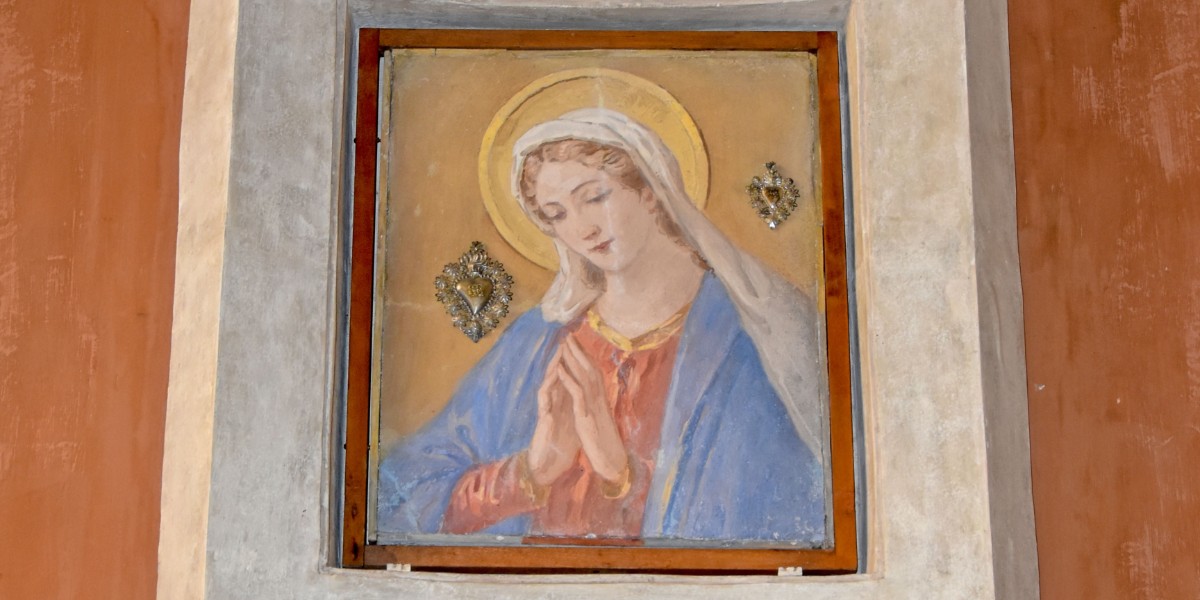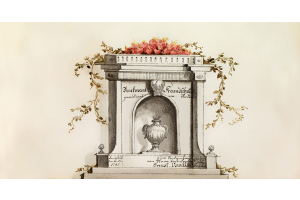
Throughout written history, women have typically been left out of history texts and ancient scroll works. When discussed, they were noted for being quiet queens to noteworthy kings and emperors. When a man rose particularly high in society, his mother was often regarded well, what a wonderful man, he must have had a fabulous mother. So here we offer a list of famous women and their memorials, mostly unknown for their prowess as a mom, but for achievements all their own. Through a myriad of memorials the globe, we are reminded of their bravery, dedication, and strength. But it’s true that they were all devoted mothers, kissers of tears, singers of lullabies, and watchdogs of curfews.
1. Abigail Adams
(Nov. 11, 1744 - Oct. 28, 1818)
First Lady, and an accomplished scribe, but also a farm manager, and devoted mom. She was the married to President John Adams at age 19, but due to his involved political career, they were seldom together. Throughout their life, Abigail, later known as “Lady Adams,” corresponded with him routinely regarding his proceedings. Many at the time thought her influence over sensitive political matters was too great, though her advice and suggestions were demurely and thoughtfully presented. Her letters are highly published and considered a valuable part of American History. Apart from correspondence with her husband and managing their home and farm, Abigail Adams devoted her life to her five children, three boys and two girls. Abigail Adams has been memorialized by her letters, several well-known paintings, a tomb at the First Unitarian Church in Quincy, and a statue of her and her son in downtown Quincy. Also, since 2003 her sculpted image has graced the Back Bay of Boston’s Commonwealth Ave Mall.
Wilma Mankiller
(Nov. 18, 1945 - Apr. 6, 2010)
Wilma Mankiller was born in Tahlequah Oklahoma on lands designated to her family by the United States Government. However, in her youth the family willingly moved to San Francisco through a government relocation act that promised her father a better paying position. Cultural isolation was difficult for Wilma and her few Native American peers. This struggle inspired her to become actively involved with Native American programs in schools, and later to be voted the first female Chief of the Cherokee Nation. With two young daughters in tow, she helped found the Community Development Department of the Cherokee Nation, and became assistant secretary for Indian Affairs at the Department of the Interior, even earning the Presidential Medal of Freedom. Membership of the Cherokee Nation more than doubled during her ten year term of service. Memorials in Native American culture are almost unheard of. However, her image and story are immortalized in a 1991 issue of Parade Magazine, and a variety of books and publications. Her memorial service drew hundreds of tribal members, including state and federal leaders. A cartoonist with Tulsa World also captured her likeness in a tasteful political cartoon.
3. Indira Gandhi
(Nov. 19, 1917 – Oct. 31, 1984)
Indira Gandhi was the first female Prime Minister in India, elected by popular vote after a bitter battle for leadership. She was the daughter of India's first Prime Minister, Jawaharlal Nehru. Mrs. Gandhi served the Congress and the country in her vigilant efforts toward a peaceful India. Not just a political figurehead, she was a devoted mother to her son Rajiv Gandhi, also one of India's great prime ministers. After her assassination in 1984 her home was transformed into a museum. Many memorials exist there for her, including a unique monument over the place of her passing. An airport and hospital were also named in her honor.
4. Coretta Scott King
(Apr. 27, 1927 – Jan. 30, 2006)
As the wife of Dr. Martin Luther King Jr. Coretta was forced to endure much hardship. After her husband’s Assassination in 1968, she cared for their four children while continuing the fight for civil rights. The Coretta Scott King Award was created in her name, recognizing African American Authors of children’s books that promote appreciation and understanding of the American Dream. She’s also the founder of the Martin Luther King, Jr. Center for Nonviolent Social Change in Atlanta, Ga. A bronze bust of Coretta and Martin Luther King Jr. stand at Union & Martin Luther King Drive Allentown PA, and a cluster of Murals, including one of the King family, graces the scene in Atlanta GA.
5. Rose Kennedy
(July 22, 1890 – Jan. 22, 1995)
Rose Kennedy is well known for her role as the elegant, dignified matriarch of the well established Kennedy political family. They’re considered American royalty by many, and Rose watched over their image with delicate dignity. Two of Rose’s children became U.S. Senators, and one, John F. Kennedy, was President. But Rose knew heartache well, burying five of her nine children in her lifetime. She saw child-rearing as a duty of love, as interesting and challenging as any profession she might have chosen. At the time of her passing, Rose had 28 grandchildren and 41 great-grandchildren. A delightful garden and Greenway in Boston is named in her honor, thickly planted with roses of nearly every color and variety.
6. Agnes Gonxha Bojaxhiu / Mother Teresa
(Aug. 1910 – Sept. 17, 2008)
Mother Teresa was considered a saint my many. But in life, she was a teacher, an anti-abortion activist, and a salve to the poor and suffering people she devoted her life to. Mother Teresa is the only woman on our list who never actually bore children of her own. She was selected for her motherly traits of selfless nurturing, devoted effort, and heartfelt love. She aided lepers, the blind, the disfranchised, and the terminally ill, who otherwise were left suffering. She established the Order of the Missionaries of Charity in 1948, a Roman-Catholic congregation of women dedicated to serving "the poorest of the poor," especially India's lowest ranks. Her exemplary life won her the Nobel Peace Prize, and the Pope’s nomination for Sainthood. Many beautiful memorials to Mother Teresa stand; most notable are the Mother Teresa Memorial House and Museum in Skopje, Macedonia, as well as a bronze bust just off the main plaza in Macedonia.
7. Mary Harris Jones / Mother Jones
(Aug. 1 1837 – Nov. 30, 1930)
Mary Harris was an average girl in her youth. Born in Ireland, she immigrated to Canada and later America with her family. After the untimely passing of her husband and children to yellow fever she joined a workers fair treatment group, the Knights of Labor, and found her calling. Her ability to educate, recruit, and organize the masses into labor unions earned her the title “Mother” by men of the railway, and "the most dangerous woman in America" by her adversaries. She founded the International Workers of the World, and was known to say, "pray for the dead and fight like hell for the living." But despite nights in jail for her public outcries and threats of assassination against her, Mother Jones was known to cling to the traditional opinion that the vast importance of a woman’s work was in the home. She is well remembered for her work, and a large memorial stands in her honor at the Union Miners Cemetery in Mount Olive in IL. The plaque states “She gave her life to the world of labor, her blessed soul to heaven, God’s finer touched her and now she sleeps.”
8. Marie Skodowska-Curie/ Madame Curie
(Nov. 7, 1867 – July 4, 1934)
Marie Curie was known as a quiet, dignified woman of merit. She was well educated in physics and mathematical sciences, assisting her husband in identifying and isolating the radium and polonium molecules, earning them, along with Henri Becquerel, the Nobel Prize. After her husband’s death, Marie raised their young daughter on her own while taking over her husband’s work. She became the first female professor an Sorbonne College. Her work earned her a second Nobel Prize, and she is still the only woman to have earned two of these prestigious awards. Marie curie is memorialized by her work, but also with images of her likeness on a stained glass medallion that rests in a University in New York, and as a brass statue in Roosevelt Park, NJ. Most notably, in 1995 her ashes were moved to an impressive tomb in the Pantheon, a monument normally reserved for men of knowledge and power.
9. Mary Wollstonecraft
(Apr. 27, 1759 – Sept. 10, 1797)
Widely considered the "Mother of Feminism", Mary Wollstonecraft is best known for her efforts toward the Women’s Rights Movement. Her essay "A Vindication of the Rights of Women", and her unpublished novel "Maria: The Wrongs of Women" were beacons for women feeling the strain of supporting families without a reliable husband. She fought against gender-based oppression, and encouraged education for women. Mary died after giving birth to her only daughter, Mary Wollstonecraft Shelley, who would become the author of "Frankenstein". Though her works for women’s rights was considerable, her memorial is a humble, rectangular stone, set in St. Pancras Old Church Yard. It remains one of the few surviving headstones from a history of bombings and vandalism.
10. Jacqueline Kennedy Onassis
(July 28, 1929 – May 19, 1994)
Jackie O’, as she was commonly called, is likely best known for her utter devotion to her children. As the matriarch of the Kennedy political family, Jacqueline Kennedy is credited for restoring the White House, dressing it in a true sense of history. She left her mark on America with a winning smile and a demure manner. Her steadfast courage after her husband’s passing won her the heart of a nation. Jacqueline Kennedy is memorialized by at Arlington Cemetery alongside her husband John F. Kennedy and the eternal flame she commissioned for his resting place. A memorial pin was also crafted at the time of her death so the Nation who loved her could commemorate her passing.
11. Queen Elizabeth/ Elizabeth Bowes-Lyon
(Aug. 4, 1900 – March 30, 2002)
A descendant of the Scottish King, Robert the Bruce, Elizabeth was brought up to know duty. Upon marrying Prince Albert of England, she became the first commoner to marry into the royal family. Together they had two daughters, Elizabeth and Margaret. When her husband was crowned King of Great Brittan, it was an honor and a duty neither expected. When Buckingham Palace was bombed during her residence there in world war two, she refused to abandon her home and her people, earning herself a special place of respect in the country. Upon the passing of her husband in 1936 she became known as the “Queen Mother.” Elizabeth remained ever vigilant of her people and her children until her passing at 101 years old. Her memorial stands near the home she guarded so well, Buckingham Palace. It was unveiled in 2009, a nine foot tall bronze bust of the Queen Mum herself wearing Order of the Garter Robes, and her well known smile. Though she lived until she was an elderly woman, the statue depicts her at the young age of 51, the time of her husband’s passing and beginning of her sole reign. A second bronze bust of the Queen Mother was erected at the London Mall, showing her in four stages of life.
12. Mary of Nazareth/ Holy Mother of God
(lived between 4 B.C. and 6 B.C.)
Mary is far-and-away the most well known mother in all history. Due to the passionate followings of her son, Jesus, and the immaculate details surrounding his conception and birth, Mary is one woman who’s story was told, is told, and will be told, for all time. There are actually three images of Mary generally held by the public at large: that of Mary of Nazareth the historical figure who lived in first-century Galilee, Mary the mother of Jesus in the first testament of the Bible, and the image of Mary Mother of God that has been generated by the Christian faith for centuries. Mary herself was a Jewish peasant from Nazareth, a town of likely no more than 400 people at the time. In all the religious writings of Mary, she is a devoted mother, showing distress and joy in the life of her son. But they were never a wealthy family, and Mary likely spent the majority of her time working and educating her children. Though scripture mentions Mary only a little after the birth of her son, she is depicted as a woman who was sure of herself, and confident in her place in society. Mary is immortalized across the globe in Catholic churches, parks, and shrines. Her image is possibly one of the most commercialized female images of all time. She can be viewed near the Basilica of the Annunciation in Nazareth, in front of the Villa Maria Academy in Immaculata PA., at the Vatican in Rome, and every Catholic Church in between. We recently wrote about Catholic Cremation and how to memorialize a Catholic with an urn.
13. Sacagawea
(1787-1812)
Sacagawea is best known for leading the Louis and Clark expedition on its journey from North Dakota Territory across the Rocky Mountains. Not only was she a lone woman amongst a party of men, but she accomplished her tasks as guide, translator, and intermediary while carrying her infant child on her back. Sacagawea walked thousands of miles in her lifetime of traveling, and knew many homes. Her memory lives on in history books as a symbol of peace and bravery. A portion of southwestern Montana near the Idaho border is now named the Sacagawea Historical Area. A bronze statue of Sacagawea was erected in a cemetery near Fort Washakie where the famous guide for Lewis and Clark is rumored to be buried. In 1954 a three-cent stamp was issued with her image, in 1994 a second, 29-cent stamp was issued, and in 2000 she was immortalized again on an American one dollar gold coin.
14. Sophie Fredericke Auguste von Anhalt-Zerbst / Catherine the Great
(April 21, 1729 – Nov. 6, 1796)
Catherine, born Sophie – a German princess in her own right, was married to the Russian Grand Duke Peter of Holstein at an early age. The arrangement turned out to be an unhappy one, and after his assassination, Sophie became the Empress of Russia, Catherine II. Russia thrived under her reign, and her efforts toward Westernization, were enthusiastic, and well received by her people. Her initiative arose from the ideas of enlightenment and her actions vastly improved social welfare. Catherine bore two children, Paul and Anna. Paul was raised to the throne after his mothers passing. Catherine is memorialized by an elegant bronze statue in her hometown, and a highly decorative piece in Russia. It rests just off Nevsky Prospekt, which is lined by the Anichkov Palace, Alexandrinsky Drama Theater, and the Russian National Library.
15. Olympias
(c.375-316)
Olympias was an Epirote princess, and eventually married the Macedonian King Philip II, to become Queen of Macedonia. She was the devoted mother of Alexander the Great. Through the great trials surrounding her life of privilege, Olympus rose and fell in power, but always held the interests of her children in high regard. She spent much of her time in voluntary exile, and after her son became king, she mostly stayed out of politics. But she is recorded as continuing written contact with him. A gold coin was commissioned in Olympia’s image, memorializing her for all time. One of these coins can be viewed at the Archaeological Museum in Thessalonik.






